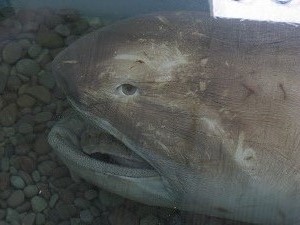Article by Ryan Kempster Support Our Sharks (Date: 01 August 2010)
 Megachasma
pelagios, or as it is more commonly known, the megamouth shark, is
one of the least understood sharks in the world today. It is an
extremely rare species of shark classified as the sole member of the
family Megachasmidae. Since
its discovery in 1976, only a small number megamouth sharks have
been observed worldwide, with only a total of 50 specimens known to
have been caught or sighted as of 2010.
Megachasma
pelagios, or as it is more commonly known, the megamouth shark, is
one of the least understood sharks in the world today. It is an
extremely rare species of shark classified as the sole member of the
family Megachasmidae. Since
its discovery in 1976, only a small number megamouth sharks have
been observed worldwide, with only a total of 50 specimens known to
have been caught or sighted as of 2010.
Support Our Sharks founder, Dr. Ryan
Kempster, was given unprecedented access to one of the oldest known
specimens of the megamouth shark.
The specimen in question stranded in Mandurah, Western
Australia in 1988, and is commonly referred to as megamouth 3, as it
was the third specimen to be recorded worldwide.
Access to the shark was given
during its move from the Museum of Western Australia to its new
place of residence at the Western Australian Maritime Museum.
The specimen had been fixed in 70% ethanol for 22 years and,
although it was apparent that some degree of tissue shrinkage had
occurred, the specimen was in extremely good condition.
The purpose of Dr. Kempster’s involvement in the move was to
create a map of the ampullary pores that make up the electrosensory
system, to learn more about how the megamouth may be using
electroreception to detect planktonic prey.
Electroreception
 Electroreception
is an ancient sense that has evolved independently across the animal
kingdom in multiple groups including lampreys, chimaeras, sharks,
skates/rays, bony fishes, and even some amphibians and mammals.
The multiple and independent evolution of electroreception
emphasises the importance of this sense in a variety of aquatic
environments.
Electroreception
is an ancient sense that has evolved independently across the animal
kingdom in multiple groups including lampreys, chimaeras, sharks,
skates/rays, bony fishes, and even some amphibians and mammals.
The multiple and independent evolution of electroreception
emphasises the importance of this sense in a variety of aquatic
environments.
The electrosensory system of sharks is
comprised of a series of electroreceptors, known as the ampullae of
Lorenzini, distributed over almost the entire surface of the head.
It is thought that the major role of the electroreceptors is
in the detection of prey, with other functions, including the
detection of predators, facilitating social behaviours and
orientation to the earth’s magnetic field for navigation.
To learn more about electroreception
CLICK HERE.
Feeding behaviour of the megamouth shark
When Nelson et al. (1997) tracked
the movements of a megamouth off the coast of California they found
that the shark performed very clear sudden vertical migrations with
the onset of sunrise and sunset.
The crepuscular depth change profiles of the megamouth were
shown to maintain a consistent level of illumination, with the shark
staying shallow at night (12–25 m depth) and deep during the day
(120–166 m depth) but still well above the sea bed at 700–850 m.
It was thought that the shark may be following aggregations
of small shrimp. To this
date little is known about the specific feeding behaviour of the
megamouth shark and how it actually locates food, so by
investigating the role of electroreception, we can start to learn
more about how this amazing animal survives in our oceans.
For more information on the feeding behaviour of the megamouth shark
CLICK
HERE.

Ryan from SOS taking a breather after completing the lectrosensory
pore mapping of the megamouth






Channing from SOS taking measurements of megamouth 3, 2010

-----------------------------------------------
Please share your thoughts about this article below.
Other Interesting Articles:
Disclaimer
Support Our Sharks posts articles and material
prepared by other organisations and individuals not affiliated with
Support Our Sharks for educational purposes. Support Our Sharks does not
necessarily agree with the opinions expressed in such material. Support
Our Sharks also provides links from this site to the websites of
featured news articles above for informational purposes only. The links
do not imply an endorsement by Support Our Sharks of these articles or
the content of their respective web pages.
